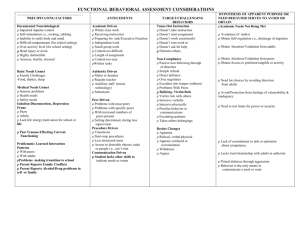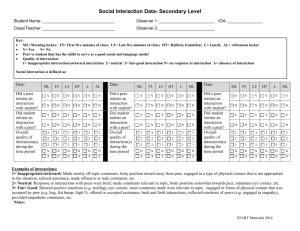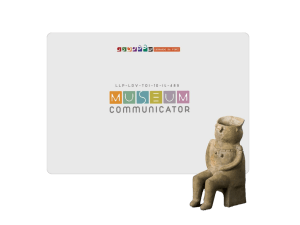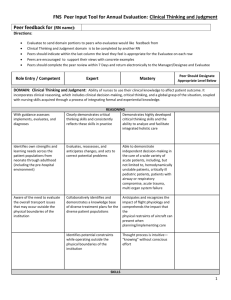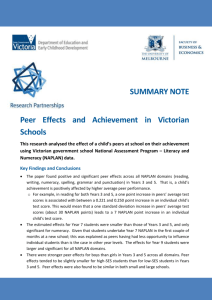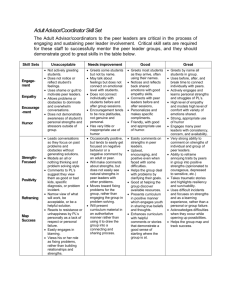This poster - Vanderbilt University
advertisement
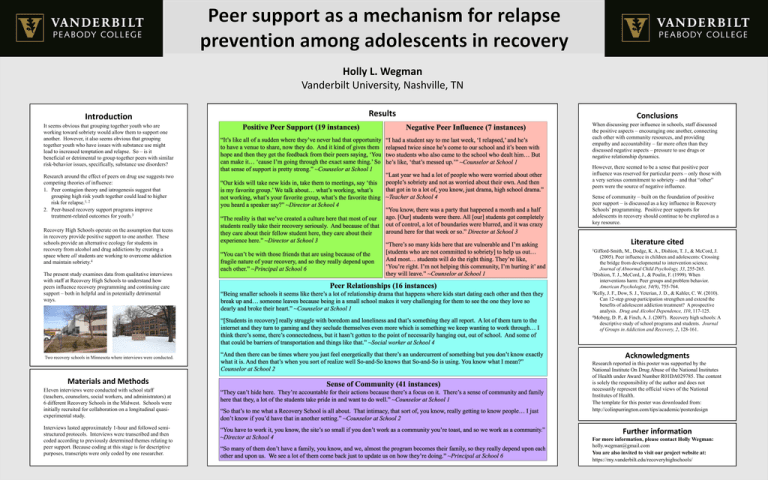
Holly L. Wegman Vanderbilt University, Nashville, TN Introduction Results When discussing peer influence in schools, staff discussed the positive aspects – encouraging one another, connecting each other with community resources, and providing empathy and accountability – far more often than they discussed negative aspects – pressure to use drugs or negative relationship dynamics. It seems obvious that grouping together youth who are working toward sobriety would allow them to support one another. However, it also seems obvious that grouping together youth who have issues with substance use might lead to increased temptation and relapse. So – is it beneficial or detrimental to group together peers with similar risk-behavior issues, specifically, substance use disorders? However, there seemed to be a sense that positive peer influence was reserved for particular peers – only those with a very serious commitment to sobriety – and that “other” peers were the source of negative influence. Research around the effect of peers on drug use suggests two competing theories of influence: 1. Peer contagion theory and iatrogenesis suggest that grouping high risk youth together could lead to higher risk for relapse.1, 2 2. Peer-based recovery support programs improve treatment-related outcomes for youth.3 Recovery High Schools operate on the assumption that teens in recovery provide positive support to one another. These schools provide an alternative ecology for students in recovery from alcohol and drug addictions by creating a space where all students are working to overcome addiction and maintain sobriety.4 The present study examines data from qualitative interviews with staff at Recovery High Schools to understand how peers influence recovery programming and continuing care support – both in helpful and in potentially detrimental ways. Two recovery schools in Minnesota where interviews were conducted. Materials and Methods Eleven interviews were conducted with school staff (teachers, counselors, social workers, and administrators) at 6 different Recovery Schools in the Midwest. Schools were initially recruited for collaboration on a longitudinal quasiexperimental study. Interviews lasted approximately 1-hour and followed semistructured protocols. Interviews were transcribed and then coded according to previously determined themes relating to peer support. Because coding at this stage is for descriptive purposes, transcripts were only coded by one researcher. Conclusions © File copyright Colin Purrington. You may use for making your poster, of course, but please do not plagiarize, adapt, or put on your own site. Also, do not upload this file, even if modified, to third-party file-sharing sites such as doctoc.com. If you have insatiable need to post a template onto your own site, search the internet for a different template to steal. File downloaded from http://colinpurrington.com/tips/academic/pos terdesign. Sense of community – built on the foundation of positive peer support – is discussed as a key influence in Recovery Schools’ programming. Positive peer supports for adolescents in recovery should continue to be explored as a key resource. Literature cited 1Gifford-Smith, M., Dodge, K. A., Dishion, T. J., & McCord, J. (2005). Peer influence in children and adolescents: Crossing the bridge from developmental to intervention science. Journal of Abnormal Child Psychology, 33, 255-265. 2Dishion, T. J., McCord, J., & Poulin, F. (1999). When interventions harm: Peer groups and problem behavior. American Psychologist, 54(9), 755-764. 3Kelly, J. F., Dow, S. J., Yeterian, J. D., & Kahler, C. W. (2010). Can 12-step group participation strengthen and extend the benefits of adolescent addiction treatment? A prospective analysis. Drug and Alcohol Dependence, 110, 117-125. 4Moberg, D. P., & Finch, A. J. (2007). Recovery high schools: A descriptive study of school programs and students. Journal of Groups in Addiction and Recovery, 2, 128-161. Acknowledgments Research reported in this poster was supported by the National Institute On Drug Abuse of the National Institutes of Health under Award Number R01DA029785. The content is solely the responsibility of the author and does not necessarily represent the official views of the National Institutes of Health. The template for this poster was downloaded from: http://colinpurrington.com/tips/academic/posterdesign Further information For more information, please contact Holly Wegman: holly.wegman@gmail.com You are also invited to visit our project website at: https://my.vanderbilt.edu/recoveryhighschools/


